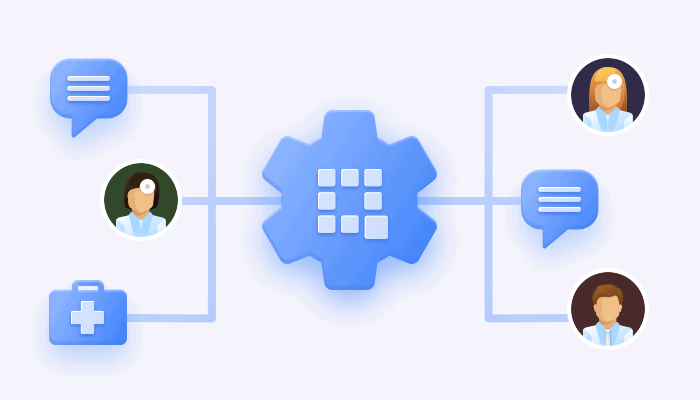
A Hospital Information System (HIS) or Hospital Management System (HMS) is software designed to manage the administrative needs of a hospital and to ensure the smooth running of operational processes. This software provides tools for logging and tracking data, managing finance and accounting, dealing with compliance and legal issues, not to mention a host of medical-related matters.
Central to effective hospital operations are clear and timely communications. Administrative staff, medical practitioners, technicians, managers, patients, and their families need to share and exchange reports, test results, personal data, requests, concerns, etc on a daily and continuous basis. Effective communication is required to ensure sound management, quality medical care, and patient satisfaction.
HIS and HMS solutions offer a mixed bag of communication features, often in the form of forums, mailing lists, and message boards. But such communication features may not be enough. Let’s explain why.
Basic characteristics for an effective messaging system in hospitals:
- Real-time communication
Communication in a healthcare setting needs to be in real-time so that time-sensitive information can be shared promptly and necessary follow-up action taken in a timely fashion. Relying on forums or message boards to exchange information leads to delayed responses.
- Better stream management
An integrated hospital management system has a stream of operations, procedures, and data in motion. An accompanying real-time messaging system provides a powerful management tool for administrators, managers, and doctors.
- Activity tracking
A messaging system works as an activity tracker and serves as a valuable log that can be used in quality assessment exercises.
- Web and mobile ready
As most of the end-users will be on the move, working at different locations, the messaging system should work seamlessly on mobile devices and tablets, as well as desktops and web browsers.
- Push notification
Push notifications are an essential part of today’s communication. As an added feature of real-time communication, they can alert hospital and medical staff, as well as patients, of the availability of important information (e.g. lab results received)
- Security
A secure environment that maintains the user’s and patient’s privacy is a necessity in any hospital integrated system. The same goes for messaging and communication.
- Compliance
In countries like the USA, Canada, Australia, the EU countries, the hospital system should comply with certain regulations. Similarly, the messaging infrastructure should comply with the same regulations.
- File and documents exchange and sharing
An instant file/document exchange among administrative and finance staff, medical professionals, and between patients and doctors is a necessity in any hospital environment.
- Quality messaging service
HD video calling, instant messaging, and high-quality audio calls are primary characteristics for enterprise and healthcare facilities. Quality instant communication ensures fast response, improved workflow, satisfied patients, and better customer experience.
- Patient self-service
The messaging system should be able to support a degree of patient interaction. It should be easy to use as well as packed with useful services like automated bots, for example, so patients can register for appointments, set-up notifications, receive test results, and so forth.
The problem
Most HIS or HIM solutions fail to offer this type of messaging system. Most hospitals have different management models and customized clinical workflows. Hence, it can be difficult to add this feature as it’s not cost or resource effective to build it from scratch.
QuickBlox communication as a messaging infrastructure for hospitals
QuickBlox offers a comprehensive and flexible infrastructure that covers hospital requirements and supports clinical workflow users. QuickBlox provides a set of powerful development tools that can be used to create new chat applications. Experienced developers can integrate QuickBlox instant messaging functionalities into an existing HIS solution as well as Enterprise Resource Planning software (ERP).
Why QuickBlox?
QuickBlox is a complete messaging infrastructure that goes beyond just creating a communication application or a video calling/ conferencing system. It saves enterprises time and resources to integrate it into their system without worrying much about hosting, security, and overall upgrades.
QuickBlox offers complete mobile-ready software development kits with a primary focus on mobile development like Flutter, React Native, Swift/ Objective-C, and Android Native SDK.
It also offers a REST-API (Server API) which is beneficial in integrating certain functionality into desktop or web systems.
Rich added values
- Improve messaging service among work colleagues, hospital employees, doctors, and patients
- Real-time file sharing
- Instant notification: Push notification
- Better mobile integration within the enterprise workflow
- Improve patient satisfaction
- Effective patient-doctor communication
- Out-of-the-box compliance
- Rich activity log
- Customized workflow which fits any clinical workflow
- Privacy-by-design is ensured
Customized clinical workflow
QuickBlox offers a complete powerful infrastructure with a rich set of development tools. It supports creating a custom implementation that fits many workflows including clinical workflow paradigms for hospitals and clinics.
Implementing and integrating a messaging and communication service within a clinical workflow improves productivity and the quality of the service as it increases patient satisfaction and decreases the margin of errors because of miscommunication and customized scalable workflow.
Battle-tested: Q-Consultation
The best example of the effectiveness of QuickBlox in healthcare is the QuickBlox-based secure communication app, Q-Consultation, which is designed specifically as a remote consultation service for enterprise with doctor-patient communication in mind.
Q-Consultation is a turn-based virtual-waiting room messaging application that organizes the workflow and appointment stream between doctors and their patients.
Unlike other messaging services and live chat applications, Q-Consultation offers a model very similar to hospital workflow. It provides a virtual waiting room for the patient, inviting them into the consultation once the doctor is ready, all the while the patient and doctor remains in their own separate home, office, or clinic.
It can fit perfectly within the clinical flow of many private and public hospitals.
Q-Consultation is not just a proof-of-concept to a customized build over QuickBlox, it’s a fully functional application that has proven to be a reliable messaging system for many enterprises especially healthcare services like hospitals and private clinical practice.
Integration-ready with healthcare solutions
QuickBlox offers a rich set of software development kits packed with detailed documentation for developers. It supports many languages with a primary focus on handheld mobile and tablet devices, but also Web technologies.
Using QuickBlox API, developers can integrate one or many of its functionalities like messaging, video/ audio calls, push notification, and file-sharing.
HIS, HMS, and ERP are all web-based applications that use web-browsers. QuickBlox offers two sets of SDKs (React-Native SDK & JavaScript SDK) and REST-API which can be used to create a digitized system within any web-based applications. Think of it in terms of extending hospital management software with a powerful messaging and file-sharing platform and the use of push notification.
Conclusion
QuickBlox is designed to speed up the development, implementation, and integration of messaging functionality into other systems, making it a perfect fit for healthcare facilities, especially when it comes to minimal infrastructure costs.
Above all, QuickBlox offers different implementation and development paradigms to suit the customized clinical workflows of individual hospitals.
Technical Index:
- HIS: Hospital Information Management System
- HMS: Hospital Management System
- EMR: Electronic Medical Record
- EHR: Electronic Health Record
- ERP: Enterprise Resources Planning
- Clinical Workflow: healthcare process encompassing all healthcare provider activities and other prescribed healthcare activities that address identified or specified health issues.








